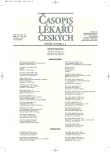Semen Quality of Pilsner University Students
Authors:
P. Hušáková; Z. Ulčová-Gallová; K. Bibková; Z. Mičanová
Authors‘ workplace:
Gynekologicko-porodnická klinika LF UK a FN, Plzeň
Published in:
Čas. Lék. čes. 2008; 147: 85-88
Category:
Original Article
Overview
Background.
Decreasing quality of the semen represents a big problem for human population. Parameters of spermiogramms are used for obtaining of information about the human semen quality. The aim of our study was to evaluate parameters of semen and its immunological characteristics in relation to data from personal history of our students.
Methods and Results.
Basic analysis of semen samples of 110 students was performed according to World Health Organization criteria. Direct mixed-antiimmunoglobulin-reaction-tests for detection of sperm-agglutinating antibodies, intraacrosomal proteins by specific monoclonal antibodies and immunoflurescence examination were used. Data from anamnesis were obtained by a questionnaire. Normozoospermia was found in 72% cases, oligozoospermia in 14%, asthenozoospermia in 5%, teratozoospermia in 4%, oligoasthenozoospermia in 5% of men. We have not confirmed negative influence of smoking, drug abuse, wearing tight clothes, hot baths, and using sauna on sperm quality. There was significantly higher percentage of students consuming presevered and spicy food more than twice a week in the group with pathological spermiogramm in comparison with the normozoospermic group. Acrosomal proteins were found in 75% men with normozoospermia and in 43% of pathological spermiogramms. Findings of sperm-agglutinating antibodies were not significant.
Conclusions.
Semen quantity as well as quality is affected by many intrinsic and extrinsic factors. Our study shows that fertility of our students is better than we expected.
Key words:
sperm quality, semen, spermiogramm.
Sources
1. Pavlásek, J., Pěknicová J., Ulčová-Gallová Z. et al.: Significance of the acrosome reaction and sperm agglutinating antibodies in human semen. Čes. Gyn., 2004, 69, s. 306–311.
2. Baker, H. W. G, Burger, H. G., DeKretser, D. M.: Relative incidence of etiologic disorders in male infertility. Male Sexual Dysfunction, 1995, 4, s. 341–352.
3. Kilgallon, S. J., Simmons, L. W.: Image content influences men’s semen quality. Biology Letters, 2005, 1, s. 253–255.
4. Sharp, R. M., Skakkebaek, N. E.: Are oestrogens involved in falling sperm counts and disorders of the male reproductive tract? Lancet, 1993, 341, s. 1392–1395.
5. Tillett, T.: Sperm Alert Environmental. Health Perspectives, 2006, 114, s. 2–3.
6. Hora, M.: Urologie pro studenty všeobecného lékařství. Praha, Karolinum, 2004, s. 103.
7. Carlsen, E., Jorgen, H. P., Anderson, A. M., Niels, E. S.: Effects of ejaculatory frequency and season on variations in semen quality. Fertil Steril., 2004, 82, s. 358–366.
8. Moline, J., Golden, A., Bar-Chama, N. et al.: Exposure to hazardous substances and male reproductive health: a research framework. Environ Health Perspect, 2000, 108, s. 803–813.
9. Safe, S.: Endocrine Disrupters and Human Health. Is there a problem? An update. Environ. Health Perspect, 2000, 108, s. 487–493.
10. Said, T. M.: Fertility Weekly, 2005, 3, s. 5-6.
11. Davoudi, M., Brossner, C., Kuber, W.: The influence of electromagnetic waves on sperm motility. Journal fiir Urologie und Urogynäkologie, 2002, 19, s. 18–22.
12. Erogul, O., Oztas, E., Yildirim, I. et al.: Effects of electromagnelic radiation from a cellular phone on human sperm motility; an in vitro study. Archive of Medical Research, 2006, 37, s. 843.
13. Fejes, I., Zavaczki, Z., Sollosi, J.: Is there a relationship between cell phone use and semen quality? Archives of Andrology, 2005, 51, s. 385–393.
14. Deepinder, F., Makker, K., Agarwal, A.: Cell phones and male infertility: dissecting the relationship, Reprod Biomed Online, 2007, 15, s. 266–270.
15. Capkova, J., Geussova, G., Peknicova, J.: Monoclonal antibody to human sperm acrosomal protein. Folia Biol., 2000, 46, s. 55–57.
16. Peknicova, J., Capkova, J., Geussova, G. et al.: Monoclonal antibodies to intra-acrosomal proteins inhibit gamete binding. Theriogenology, 2001, 56, s. 211–223.
17. Peknicova, J., Moos, J.: Monoclonal antibodies against boar acrosomal antigens labeling undamaged acrosomes of spermatozoa in immunofluorescence test. Andrologia, 1990, 22, s. 427–435.
18. Peknicova, J., Moos, J., Mollova, M. et al.: Changes in immunochemical localization of acrosomal and sperm proteins in boar spermatozoa in during capacitation and induced acrosome reaction. Anim. Reprod. Sci., 1994, 35, s. 255–271.
19. Nelson, C. M., Bunge, R. G.: Semen analysis: evidence for changing parameters of male fertility potential. Fertil Steril., 1974, 25, s. 503–507.
20. WHO (World Health Organization): WHO Laboratory Manual for the Examination of Human Semen and Sperm-Cervical Mucus Interaction. 4th ed. Cambridge, 2000.
21. Asklund, C., JŅrgensen, N., Skakkebĺk, N. E., Jensen, T. K.: Increased frequency of reproductive health problems among fathers of boys with hypospadias. Hum. Reprod., 2007, 22, s. 2639–2646.
22. Jung, A., Strauss, P., Lindner, H. J., Schuppe, H. C.: Influence of heating car seats on scrotal temperature. Fertil. Steril., 2007, 2, s. 125–129.
Labels
Addictology Allergology and clinical immunology Angiology Audiology Clinical biochemistry Dermatology & STDs Paediatric gastroenterology Paediatric surgery Paediatric cardiology Paediatric neurology Paediatric ENT Paediatric psychiatry Paediatric rheumatology Diabetology Pharmacy Vascular surgery Pain management Dental HygienistArticle was published in
Journal of Czech Physicians

Most read in this issue
- The Occurrence of Malignancies in Former Blood Donors
- Complications with the Pocket of Cardiostimulator
- Tracheal Intubation without Muscle Relaxant – the Impact of Different Sufentanil Doses on the Quality of Intubating Conditions: A Prospective Study
- Is the Extent of Present Examination of Blood Donors Sufficient? Malignancies in Active Blood Donors
